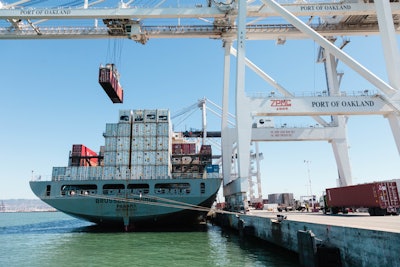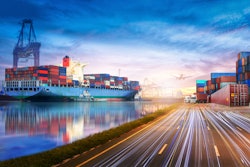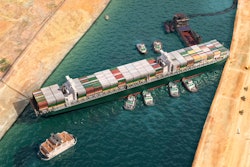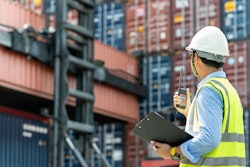
If necessity is the mother of invention, then the pandemic-induced supply chain breakdowns of the past two years are certain to yield new solutions for expediting world trade in the future. Short-term measures, such as ocean carriers adding capacity, diverting some cargo to less congested ports and ports implementing 24/7 operations will only help so much.
Here are three permanent fixes on the horizon.
Peel-off container stacks are not just a passing fad
A peel pile, peel-off or flow stack is a relatively new operating concept introduced in some ports around 2015. It has grown in popularity in recent years to help alleviate severe port congestion, particularly in West Coast ports.
In a peel-off operation, containers belonging to participating cargo owners and trucking companies are pre-positioned in separate stacks at a port after discharge from a vessel. The user’s designated trucker(s) takes delivery from the grouped containers on a last-in, first-out basis – essentially “peeling” the containers off from the top of the stack.
While large shippers – those filling stacks of upwards of 50 containers or more – have leveraged peel-off operations most effectively to date, we see this practice becoming the norm for most shippers within the next five years. Here’s why:
- The trade will continue to use the ports of Los Angeles/Long Beach as the gateway to the United States even if there are other viable options available. Los Angeles/Long Beach ports are well beyond their capacities to handle the volume throughput required. That’s why there have been 80-110 vessels sitting anchored idle offshore on any given day waiting to come in for the past two years.
- Importers need predictability and low costs. Today’s situation is a well-documented crisis, causing delays to cargo availability and staggering demurrage costs that can reach as high as $3,000-4,000 per container.
- Optimizing a trucker’s time will become a priority. Today, truckers sit in lines for hours waiting for terminal workers to find, retrieve and load specific containers costing them hours of lost productivity. Additionally, warehouse labor does not want to work extended shifts, nor do the truckers and longshoremen.
One solution is to achieve greater efficiencies in the port today and in the future is by utilizing peel-off stacks. Doing so reduces container handling efforts by 50% or more because positioning moves are eliminated. Every container lifted off the stack goes onto a truck. The result is an enormous increase in terminal capacity and faster trucker turn times – a welcome improvement for terminals looking for space, shippers looking for predictability and motor carriers seeking to maximize productivity and profitability.
The growing use of peel-off stacks will also yield greater flexibility in determining delivery timing. Today, one of the hesitations to adopting this operating model is a delivery-to-warehouse window of 4-5 days. But, once peel-offs are the norm, terminals will be able to build far more refined stacks. For example, container volumes will enable a Monday afternoon stack and a Tuesday morning stack and so on. Importers may not be able to stipulate which stack their container goes into, but they will know which one it is in, and thus be able to inform the warehouse when to expect the container delivery.
Technology and data sharing, particularly with U.S. customs, will help speed adoption even with smaller shippers who will take advantage of aggregated container stacks.
Customs clearance will become automated for everything except first-time classification of cargo
Today, ocean freight is generally cleared within two days of a vessel’s arrival in port, though there are some instances where it could be up to four days prior. Cargo will need to be cleared by U.S. customs at least five days prior to vessel arrival to speed cargo throughput and facilitate peel-off stacks at ports. The fundamental mechanisms are already in place to make this a reality.
Peel-off stacks will be facilitated by automated manifest system (AMS) and importer security filing (ISF) service providers transmitting shipment information to U.S. customs 24 hours prior to cargo loading onto vessels at origin. This AMS and ISF shipment data represents approximately 85% of the entire data set required by customs for entry into the United States. The only additional information comes from the commercial invoice showing the SKU numbers, the value of each SKU item and its extended value. The SKU is then classified and assigned a harmonized tariff schedule (HTS) code. The rest of the duty and tax calculations are driven from those codes, which can be saved and referenced on subsequent shipments.
Following the initial shipment, the next load for export will require a new AMS shipment setup describing the full shipment details. The ISF will be a copy from the previous shipment and the shipper or seller will upload the commercial invoice to the AMS transmission file. The commercial invoice can then be read by optical character recognition (OCR)/artificial intelligence (AI). The SKU description will be looked up and matched to the previous shipment and the price per unit and total value will also be extrapolated from the commercial invoice. This process generates logical calculations and makes full automation possible.
To summarize, the key to successful adaptation is to have the shipment data standardized for both U.S. customs requirements and the AMS process. The rest is a look up of previous data, which does not require direct human interactions.
Why the Puget Sound Gateway makes sense
Port capacity needs to be expanded on the West Coast where there are only three major port city complexes: Los Angeles/Long Beach, San Francisco/Oakland, and Seattle/Tacoma in Puget Sound. One might argue that Portland to the south would qualify, but the Columbia River delta leading into Portland is too shallow for today’s container ships. There are no other major port cities along the West Coast with deep water and the requisite infrastructure to serve as a U.S. gateway.
While Los Angeles/Long Beach and San Francisco/Oakland have deep harbors and infrastructure, they are at full capacity – some would say over capacity as evidenced by the many ships that routinely have to anchor offshore waiting for a berth. Both commercial port zones are encircled by mountains limiting the nearby land available for commercial development. In Oakland, officials are even considering eliminating some port property to build a new Major League Baseball stadium.
In contrast, the ports of Seattle and Tacoma are part of the Puget Sound region, which is over 150 miles long North to South and is one of the best deep-water harbors in the world. There is ample property on the east side of the sound that could be developed and even more untapped open land on the west side. This includes both deep waterfront land for terminal development and property inland for expansion of warehousing and distribution.
A robust supporting infrastructure and labor force are also key.
Seattle/Tacoma is already served by both the Burlington Northern and Union Pacific railroads and both companies have plenty of track running to the six major inland rail hubs in Minneapolis, Chicago, St. Louis, Kansas City, Memphis, and Dallas. These tracks can be expanded without having to purchase new land.
Seattle/Tacoma has major freeways running both North and South (I-5) and East and West (I-90) for the over-the-road transport. There are no alternative West Coast harbors with direct interstate access other than the California port cities, which are already at capacity.
On the labor front, Seattle and Tacoma are in large and growing communities that attract and retain significant numbers of trade and transportation workers, unlike smaller alternative ports.
Looking ahead, the United States needs additional port capacity to support the continued long-term growth of international trade via the West Coast. We see that growth occurring in the Puget Sound region. Seattle/Tacoma has deep water, protected harbors, plenty of developable land, truck and rail connectivity to the inland United States and an ample labor supply. No other region, outside of Canada, can compete with it for available growth potential.
The current shipping crisis has magnified the shortcomings of the way waterborne international trade is handled. Implementation of the three major developments will go a long way to ensuring faster throughput for increasing cargo volumes.




















